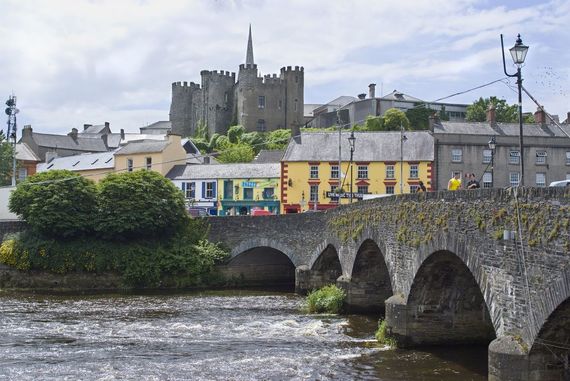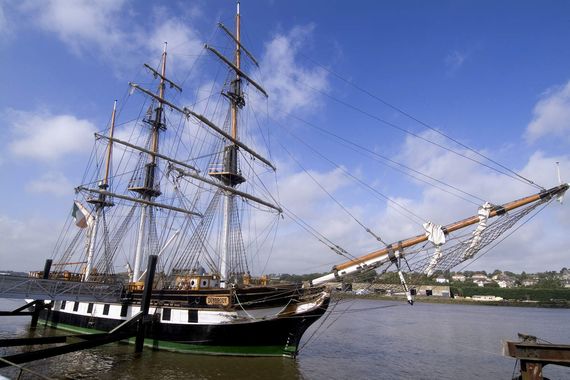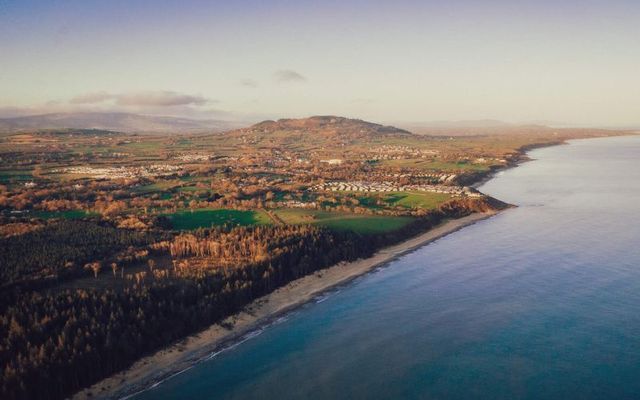Thanks to its 250 kilometers of golden beaches, world-class towns, and dramatic history that witnessed both Viking and Norman invasions — not to mention Irish rebellions — there’s something for everyone in County Wexford, Ireland's ‘Sunny Southeast’.
Yes, County Wexford’s warm weather delights, but it doesn’t mean they aren’t prepared for challenging conditions — case in point, the first stop on my itinerary during a recent trip: Hook Lighthouse, which has navigated ships to safety for 800 years. As a testament to its importance, the commanding structure appears on the county’s coat of arms.
While ascending the 115 spiral steps, I learned from manager Lorraine Waters that the lighthouse’s story can be traced back to a fifth-century Brittonic monk, Saint Dubhan, who illuminated the night sky with a simple beacon. Following the development of New Ross port in the 13th century, William Marshal — Strongbow’s son-in-law — commissioned this grand tower, which stands largely in its original state today and is thought to be the world’s oldest working lighthouse.
While its first custodians were monks, in recent years, the responsibility fell onto workers, often from the local area — at least until 1996, when an automatic operation was introduced. In addition to its practical use, Lorraine, a qualified engineer, praised Hook Lighthouse and the café as fantastic social outlets.

Hook Lighthouse.
“I love working here,” she enthused. “It’s the lights, eyes, and ears of the southeast — it’s an honor for my team to be the latest custodians.”
If it weren’t for the steep ascent already taking my breath away, the vistas from the balcony would do just that. I marveled at the jagged coastline and turquoise seas, which, Lorraine added, double as the graveyard for a thousand vessels — notably the doomed Cromwellian flagship, ‘Great Lewis’.

Love Irish history? Share your favorite stories with other history buffs in the IrishCentral History Facebook group.
All God's Creatures
While I failed to glimpse the marine mammals frequenting these waters — including dolphins and even whales — I was delighted to meet a bob of seals in Seal Rescue Ireland, located in the popular seaside village of Courtown. Team member Tiffany Brockman revealed that the charity rescues, rehabilitates, and releases sick, injured, and orphaned seals.
“There are hundreds of volunteers throughout the Republic, who’ve received online training,” Tiffany explained. “They transport vulnerable seals here — it’s a nationwide community effort.”
She outlined the importance of seals in maintaining balance in our ecosystem, adding that the principal challenges for seals are plastic ingestion and entanglement — highlighting the importance of bringing our rubbish home. Tiffany, who lives with colleagues in shared accommodation nearby, said SRI relies on donations.
We explored the hospital and met the seals in their care — fittingly, these little fighters have received names of Irish warriors and legends like Fionn, Danú, and Caer.
My experience with God’s creatures continued some 30 kilometers west in Secret Valley Wildlife Park. Spearheaded by animal-lover Ann O’Connor, the facility has a mix of international animals — many of whom are rescues — including monkeys, alpacas, llamas and the majestic 10-year-old tortoise, Toby. Ann opened the zoo in 2007 on the farm belonging to her late grandmother.
“I’ve loved animals since I was a child,” she told me as I waved at lemurs mischievously playing in their quarters. “I went to agricultural college and completed a zoology course. This has always been a dream of mine.”
She added: “Our mission is to educate our visitors while giving them an entertaining experience, leading to greater respect for animals.”
A Presidential Garden
Mother Nature showcases all her glory at the JFK Arboretum. Spanning 252 hectares, this sprawling amenity was created to honor the late US president, whose great-grandfather, Patrick, hailed from nearby Dunganstown.

The Kennedy Homestead.
In the visitor center, staff member Leona Tuck explained that Cork activist Seán Patrick Keating was so upset by his friend’s assassination that he wanted to pay tribute. “He began fundraising and, along with the government, created this arboretum.”
When I quizzed her on why an arboretum was chosen as a memorial, Leona beautifully said: “In Ireland, given our storied past, trees and the land are closely linked to our identity — and plants are used as a vehicle of nationalist expression — making this the perfect tribute to JKF and his Irish ancestors.”
Leona, who grew up in County Clare, added that the arboretum contains 4,500 trees and shrubs — including 500 different rhododendrons and several endangered conifer species. On a fine day, visitors can see six counties from the summit. After detailing the wildlife here — namely red squirrels and red foxes, unable to resist the long meadows in summer — Leona named the melodic birdsong as a personal highlight.
But animals aren’t the only visitors here — the arboretum has welcomed JFK’s family over the decades, including his daughter, Caroline, who opened an exhibition in 2013.
Times Past
Across Wexford are historic properties representing architecture at its finest. Looming large over picturesque Enniscorthy is the town’s 13th-century castle. Previously home to Norman knights, English earls, and local merchants, today it’s an eclectic museum.

Enniscorthy.
My guide, Mary Brickley from Ferns, revealed that in the 1960s, Michael Tobín — father of the famed author of Brooklyn, Colm — was instrumental in developing the castle into its current visitor-friendly incarnation.
Highlights here include the exhibitions celebrating wall art and local architect and designer Eileen Gray — a pioneer of the Modern Movement. In 2009, her ‘Dragons’ armchair sold for €21.9 million at auction, setting a record for 20th-century decorative art.
The roof offers views of Vinegar Hill — a pivotal and bloody site during the 1798 rebellion — while bullet scarring from the Civil War is etched into the walls.
Elsewhere in the county, Wells House is a Victorian Tudor Gothic property initially built by John Warren — a soldier loyal to Cromwell. It later passed to barrister and politician Sir Robert Doyne, who ran the estate for 260 years. Its current owners are Uli Rosler and his wife, Sabine.
The picture-perfect property is surrounded by 450 acres of woodlands and gardens — and an animal farm, which, I learned, counts Hollywood star Channing Tatum as a visitor, drawn here by the lure of meerkats!
In the remarkable Johnstown Castle Estate — located a whisper from Wexford town — the star attractions aren’t meerkats but peacocks, sashaying around the lakes and walled gardens.
Embracing the growing popularity of tourism in the region, the estate — with a history spanning 800 years — relaunched in 2019, offering a ‘3-in-1’ destination. In addition to the gardens and tours of the Gothic-Revival castle, there are excellent exhibitions housed in the former stables documenting Irish agriculture, including the Famine years.

Are you planning a vacation in Ireland? Looking for advice or want to share some great memories? Join our Irish travel Facebook group.
The Great Hunger
Ghosts of the Great Hunger linger in County Wexford. The Dunbrody Famine Ship in New Ross is an authentic reproduction of an emigrant vessel from the 1840s when a million and a half people left Ireland, desperate to survive. With the help of interactive theater sets, exhibitions, and talented actors, I received a unique insight into the fortitude of these people, who were subjected to unimaginable conditions crossing the Atlantic to America and Canada.

Dunbrody Famine Ship.
The ship was initially intended for cargo but was later repurposed to accommodate passengers, who were only allowed on deck for an hour a day. More positively, Wales’ Captain John Williams was popular in his role, thanks to his medical experience — a helpful requirement given the diseases that emerged over the six-to-eight-week voyage. Even so, vessels like the Dunbrody earned the moniker ‘coffin ships’, owing to the number of deaths on board.
Today, the vessel cuts a fine figure along the banks of the River Barrow — beside it is the Emigrant Flame burning brightly and permanently to remember emigrants worldwide. Astonishingly, in 2013, a group gathered at the graveside of JFK in Arlington Cemetery and lit a torch from the eternal flame memorial before transporting and using it here.
Ripe For The Picking
No visit to Wexford is complete without picking strawberries. I visit The Village at Wheelocks — a family-run farm outside Enniscorthy. After placing more of the delicious red fruit in my mouth than my bucket, I immediately understood why the Wexford variety is said to be the best in the world.
“Wexford’s mild climate combined with our soils make great conditions for growing strawberries,” explained Cyril Wheelock, whose family has been producing the crop here since the 1950s.
“It’s lovely to be a part of nature,” he said when describing his job’s perks. “A woman from Australia visited specifically to pick strawberries — it was on her bucket list. I loved that we could facilitate that.”
A year before the pandemic hit, Cyril and his wife, Margaret, expanded their offering by opening a state-of-the-art restaurant, playground and market. In one of the wooden stores, I meet Hilary Jordan, who, along with her husband, Dave, runs the craft business Fingerprint Mementos.
“When you come here, there’s no hurry on you,” Cyril explained. “There’s an atmosphere here — somewhere to escape the chaos.”
After lunch, armed with buckets of strawberries, I asked Cyril what his hopes are for the future of The Village at Wheelocks.
“My three sons have their own jobs, but they’re very involved in the business,” he said, a smile spanning the width of his face. “Having someone to pass the business onto is like winning the lottery.”
Unlike me, I hope the trio can show more restraint with their delicious stock.
Hotel Intel
Wexford is one of the Emerald Isle’s nicest towns, bustling with shoppers, foodies, and art lovers — especially opera aficionados who descend annually for the festival, a highlight in Ireland’s cultural calendar. Unsurprisingly, the town has top-notch accommodation offerings, including the four-star Whitford House Hotel.
Located on the outskirts of the town, this family-run establishment, with its attractive bedrooms and interior, has welcomed guests for 50 years and prides itself on combining old-world charm with first-class facilities.
“County Wexford is one of the most popular staycation destinations in Ireland because there’s so much choice here — from mountains to beaches and everything in between,” senior staff member John Carty told me when we met in the hotel’s bistro, jam-packed with happy punters. “Being a local, I’m proud to see so many people visit — and the Whitford House Hotel makes a perfect base.”
Outside Gorey — a town famed for its selection of independent boutiques and stores — stands the contemporary Ashdown Park Hotel, owned by brothers Tom and Pat Redmond, whose hotel portfolio includes family-favorite Amber Springs.
During my stay, I was particularly impressed by the excellent staff members, whose years of experience welcoming guests shows in every smile. Ashdown Park Hotel is also understandably a honeypot for food lovers, thanks to the local produce served in the award-winning and beautifully refurbished Rowan restaurant. After being wowed by the farm-to-fork experience, it was unsurprising to learn that in addition to being hoteliers, the Redmond brothers are farmers as well.
* Originally published in 2023, updated in May 2024.




Comments